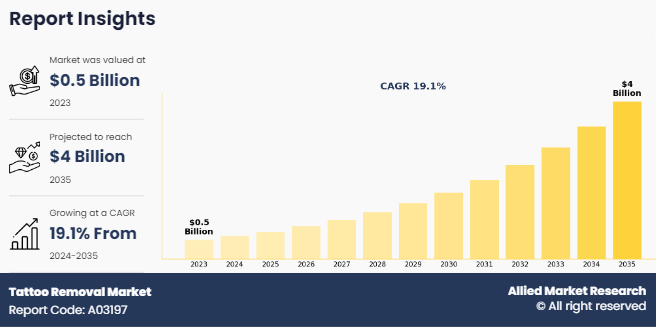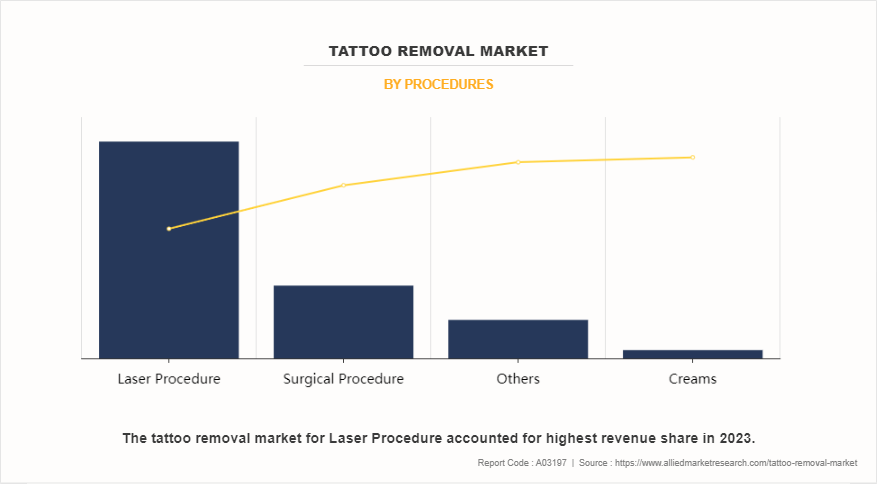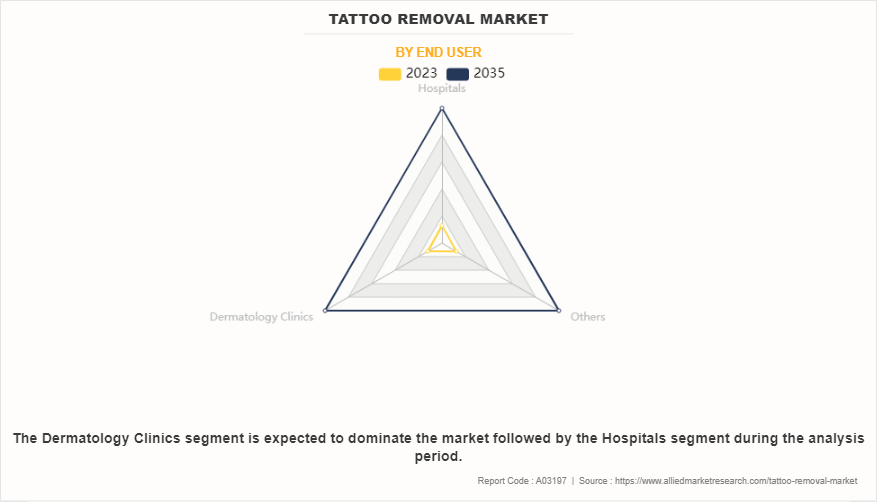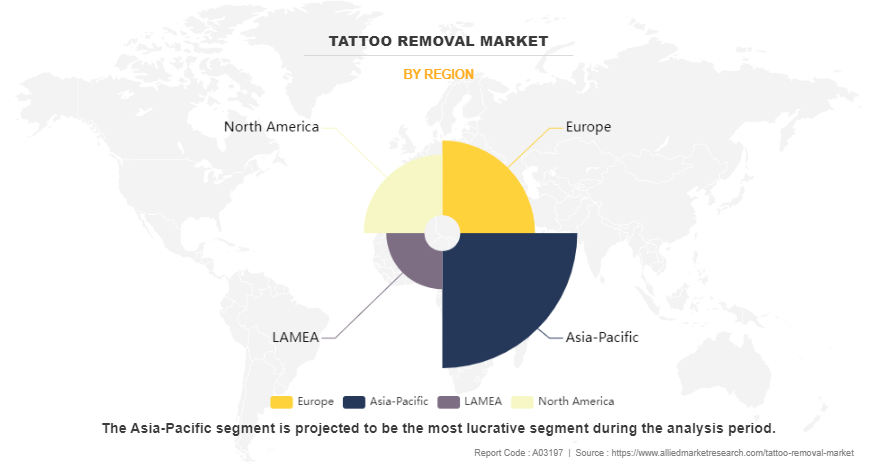Tattoo Removal Market Research, 2035
The global tattoo removal market was valued at $0.5 billion in 2023, and is projected to reach $4.0 billion by 2035, growing at a CAGR of 19.1% from 2024 to 2035. The growing popularity of tattoos has led to a corresponding increase in demand for tattoo removal services. According to an article published in March 2024, approximately 23% of the population regrets at least one of their tattoos and plans to have tattoos removed in the future. This growing desire for tattoo removal is a significant driver of market expansion, as more people seek to address unwanted tattoos for personal, professional, or aesthetic reasons. With a sizable portion of the population expressing interest in tattoo removal, the market is poised for further growth to meet the evolving needs and preferences of consumers.

Tattoo removal refers to the process of eliminating or fading unwanted tattoos from the skin. Various techniques and technologies, such as laser therapy, intense pulsed light (IPL), surgical excision, and chemical methods, are used to break down the tattoo pigment particles embedded in the skin's dermal layer. During tattoo removal procedures, the targeted pigment absorbs energy from the treatment device, causing it to fragment into smaller particles that are gradually absorbed and eliminated by the body's natural processes. Over multiple treatment sessions, the tattoo fades progressively, resulting in reduced visibility or complete removal. Tattoo removal procedures are performed by qualified healthcare professionals, such as dermatologists or trained laser technicians, to achieve safe and effective outcomes.
Key Takeaways
- By procedures, the laser procedure segment were the major revenue contributor in tattoo removal market size in 2023 and is anticipated to register the fastest CAGR during the forecast period.
- On the basis of end user, the clinics segment accounted for the highest revenue in 2023 and is anticipated to grow at the fastest CAGR during the forecast period.
- Region-wise, Asia-Pacific generated the largest revenue in 2023 and is anticipated to grow at the highest CAGR during the tattoo removal market forecast period.
Market Dynamics
The tattoo removal market is witnessing significant growth, owing to increase in tattoo regrets and non-acceptance of tattoos in military and government jobs. This has led to heavy investments from key players in R&D and technological advancements in different tattoo removal treatments. Presently, the latest method trending for tattoo removal includes intense pulsed light therapy, which is considered superior as compared to laser for removing tattoos. This is attributed to the fact that this procedure needs lesser treatment sessions and shorter time to completely remove tattoos compared to laser treatments. Scientists are also focused on discovery of improved & novel methods for erasing tattoos, within lesser time.
In addition, the market is expected to grow substantially during the forecast period as most of the population is embracing the available laser tattoo removal solutions to improve their skin appearance after tattoo removal. Since each laser is responsible for targeting a different family of colors, companies are investing in developing products that remove an entire spectrum of colors in fewer treatment cycles. For instance, In March 2023, Candela Corporation (Candela), a leading global medical aesthetic device company headquartered in Marlborough, MA, announced that the PicoWay laser system has received FDA clearance and Health Canada licensing for expanded indications, including the challenging condition of melasma.
Moreover, Cynosure, Inc., one of the leading manufacturers and suppliers of a wide range of energy-based aesthetic and medical treatment systems, provides a PicoSure energy delivery system, which is designed to remove full color spectrum of tattoo in limited treatment cycles. Thus, growing initiatives taken by the key players in tattoo removal technologies are anticipated to offer remunerative opportunities for tattoo removal market growth in the forecast period.
Furthermore, the increasing demand for non-invasive procedures for aesthetic purposes is a significant driver of growth in the tattoo removal market. Non-invasive tattoo removal procedures offer individuals a safer and more convenient alternative to traditional surgical methods, reducing the risk of scarring and minimizing downtime. As more people seek to modify or eliminate unwanted tattoos for personal, professional, or aesthetic reasons, the demand for non-invasive tattoo removal treatments continues to rise.
Moreover, advancements in technology have led to the development of more effective and efficient non-invasive tattoo removal devices and techniques, further fueling market growth. With the growing popularity of cosmetic procedures aimed at improving appearance and enhancing self-confidence, non-invasive tattoo removal has emerged as a preferred option for individuals seeking to address tattoo regret or modify their personal image without undergoing invasive surgery.
However, the high cost associated with tattoo removal procedures acts as a significant barrier to market growth. Tattoo removal treatments often require multiple sessions over an extended period, which can result in substantial cumulative costs for patients. Additionally, advanced laser technologies and specialized equipment used in tattoo removal clinics contribute to the high cost of these procedures. As a result, many individuals may be deterred from pursuing tattoo removal due to financial constraints, limiting the accessibility of these services and impeding market expansion. Addressing cost barriers through pricing strategies or insurance coverage could help alleviate this constraint and promote market growth.
Furthermore, celebrities and social media influencers play a pivotal role in shaping public perceptions and trends, including attitudes towards tattoo removal. By publicly sharing their tattoo removal journeys and outcomes, whether through personal anecdotes or visual content, they destigmatize the process and make it more relatable to their followers. This normalization of tattoo removal helps reduce societal taboos surrounding tattoo regret and encourages individuals to explore removal options without fear of judgment. As a result, consumer interest in tattoo removal services increases, it is anticipated to drive market demand and growth.
Segments Overview
The global tattoo removal industry is segmented into product, procedures, end user, and region. On the basis of procedures, the market is fragmented into laser procedure, surgical procedure, creams, and others.. On the basis of end user, the market is bifurcated into hospitals, clinics, and others. Region-wise, the market is analyzed across Asia-Pacific (U.S., Canada, and Mexico), Europe (Germany, France, UK, Italy, Spain, and rest of Europe), Asia-Pacific (China, Japan, India, Australia, South Korea, and rest of Asia-Pacific), and LAMEA (Brazil, South Africa, North Africa and rest of Middle East & Africa).
By Procedures
Depending on procedures, the market is divided into laser procedure, surgical procedure, creams, and others. The laser procedure segment accounted for the largest tattoo removal market share in terms of revenue in 2023 and is expected to exhibit the fastest CAGR during the forecast period. This growth is attributed to key factors such as increase in demand for laser technology, shift in preference of individuals toward laser tattoo removal rather than surgical removals, and various advantages offered by laser procedures have made it a safer and reliable tattoo removal technique.

By End user
By end user, the market is segregated into hospitals, clinics, and others. The clinics segment accounted for the largest tattoo removal market share in terms of revenue in 2023 and is expected to exhibit the fastest CAGR during the forecast period. This is attributed to preference among individuals for clinics, owing to availability of advanced equipment for tattoo removal as compared to hospitals and other end users and rise in number of tattoo removal clinics across the globe. Moreover, tattoo removal procedures in clinics offer advantages such as presence of skilled professional ensuring minimal scarring, avoidance of wounds, and no loss of skin texture during or after the removal treatment.

By Region
Region-wise, the tattoo removal market is analyzed across Asia-Pacific, Europe, Asia-Pacific, and LAMEA. Asia-Pacific acquired the largest tattoo removal market size in terms of revenue in 2023 and is expected to exhibit the fastest growth during the forecast period. This growth is fueled by increasing disposable income, rising awareness of aesthetic procedures, and the availability of advanced technologies. Additionally, cultural shifts and changing beauty standards in the region contribute to heightened demand for aesthetic treatments, including tattoo removal services.

Competitive Analysis
The major players such as Alma Lasers and Cynosure have adopted product launch, collaboration, acquisition, product development, and product approval as key developmental strategies to strengthen their foothold in the competitive market. For instance, In September 2021, Austin-based Removery, the world leader, announced a key strategic acquisition of Clean Slate Laser, the industry leader in tattoo removal businesses in the United States.
Recent Developments in Tattoo Removal Industry
- In March 2020, Lumenis Ltd., the world's biggest energy-based medical device business for aesthetic, surgical removal, and ophthalmic applications announced the release of the Stellar M22TM, its newest and most advanced platform. The redesigned user interface on the Stellar M22 has a bigger screen that allows for shorter treatment times and more convenient monitoring from a distance.
- In February 2022, Ray Studios, a Paris-based firm, is attempting to address the problem of tattoo removal with new technology and a fresh take on the process. The company has collected $3 million to support its plans to create 200 studios worldwide in the next five years. AirAngels and Gaingels from the United States and Kima Ventures, Nickleby Capital, and True Capital from Europe participated in the round. It follows a "successful soft opening," according to Ray Studios, with its first studio opening in Paris in December.
Key Benefits for Stakeholders
- This report provides a quantitative analysis of the market segments, current trends, estimations, and dynamics of the tattoo removal market analysis from 2023 to 2035 to identify the prevailing tattoo removal market opportunity.
- The market research is offered along with information related to key drivers, restraints, and opportunities.
- Porter's five forces analysis highlights the potency of buyers and suppliers to enable stakeholders make profit-oriented business decisions and strengthen their supplier-buyer network.
- In-depth analysis of the tattoo removal market segmentation assists to determine the prevailing market opportunities.
- Major countries in each region are mapped according to their revenue contribution to the global market.
- Market player positioning facilitates benchmarking and provides a clear understanding of the present position of the market players.
- The report includes the analysis of the regional as well as global tattoo removal market trends, key players, market segments, application areas, and market growth strategies.
Tattoo Removal Market Report Highlights
| Aspects | Details |
| Forecast period | 2023 - 2035 |
| Report Pages | 275 |
| By Procedures |
|
| By End User |
|
| By Region |
|
| Key Market Players | Berry Global Group, Inc., sisram medical(alma lasers), Fotona, Soliton, Inc., cipher pharmaceuticals inc., Lumenis Ltd., Cynosure, Candela Corporation. |
Analyst Review
The tattoo is a permanent or temporary mark made on body, which is inked by inserting ink under the skin. People tend to get rid of their tattoos, owing to many reasons such as social environment, career purposes, change in lifestyle, and personal situations. Thus, people pursue for a reliable way to remove their tattoos. Colored tattoos require extra efforts for removal, while black-inked designs are easily removed. Laser procedure is the most common tattoo removal procedure adopted to remove tattoos, and it is anticipated to grow at the highest rate during the forecast period.
In addition, rise in government support for R&D of novel tattoo removal lasers, increase in adoption of non-invasive tattoo removal procedures, and surge in demand for tattoo removal techniques in aesthetic or dermatology clinics are expected to drive growth of the tattoo removal market.
Furthermore, Asia-Pacific is expected to remain dominant during the forecast period. This is driven by increasing tattoo prevalence, rising disposable income, and expanding aesthetic awareness, fostering greater demand for tattoo removal services in the region. In addition, the growing technological advancements are further potentially driving the market growth.
The total market value of tattoo removal market is $0.5 billion in 2023.
The forecast period for tattoo removal market is 2024 to 2035
The market value of tattoo removal market in 2035 is $4.0 billion
The base year is 2023 in tattoo removal market .
Top companies such as Sisram Medical (Alma Lasers),Cipher Pharmaceuticals Inc., Soliton, Inc., Cynosure, Candela Corporation, held a high market position in 202
3. These key players held a high market postion owing to the strong geographical foothold in North America, Europe, Asia-Pacific, LAMEA.
The laser procedure segment is the most influencing segment in tattoo removal market . This growth is attributed to key factors such as increase in demand for laser technology, shift in preference of individuals toward laser tattoo removal rather than surgical removals, and various advantages offered by laser procedures have made it a safer and reliable tattoo removal technique.
The major factor that fuels the growth of the tattoo removal market are increasing tattoo popularity, advancements in laser technology and professional and social factors
Tattoo removal refers to the process of eliminating or fading unwanted tattoos from the skin. Various techniques are employed to break down the tattoo pigment particles embedded in the skin, allowing the body's natural processes to gradually remove them.
Loading Table Of Content...
Loading Research Methodology...


